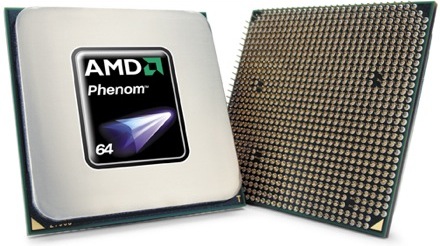Page 2 - Specs, socket, power consumption
The Phenom X4 Series
AMD, as you guys know, released in September the first Quad Core based processors already, Barcelona (earlier on Agena). They have been inserted into the server market under the Opteron brand. Today we look at virtually the same processor yet at end-user level, consumers. It's branded Phenom and is obviously based on the "Barcelona" multi-processor technology. AMD introduced three Phenom models of processors; the Phenom 9500, 9600 and a soon to be released 9700 at 2.2, 2.3 and 2.4GHz respectively.
| Model | Speed | Socket | L2 Cache | L3 Cache | HT Bus | TDP | Launch |
| Phenom X4 9700 | 2.4 GHz | AM2+ | 4 x 512KB | 2MB | 4.0 GHz | 125W | Nov.19, 2007 |
| Phenom X4 9600 | 2.3 GHz | AM2+ | 4 x 512KB | 2MB | 3.6 GHz | 89W | Nov.19, 2007 |
| Phenom X4 9500 | 2.2 GHz | AM2+ | 4 x 512KB | 2MB | 3.6 GHz | 89W | Nov 19, 2007 |
Here's one good thing about the new Quad core technology, AMD is going to price it aggressively, check it out.
Prices
Phenom 9600 : 190 euros vat excluded
Phenom 9500 : 169 euros vat excluded
This pricing level places it in line with the quad core Intel Core 2 Q6600, which is where AMD needs to be. There is no high-end Phenom processor released just yet. So do not expect an AMD 1000 EUR processor for sale anytime soon ... except something dark.
An unlocked, overclockable Black Edition 2.3-GHz Phenom will also be available later this year. The rumored 2.6-GHz Phenom 9900 won't be available until the first quarter of 2008, and should cost below $350 when it's released. The sub-$300 2.4-Ghz 9700 part is scheduled to ship in the same timeframe.

ArchitectureLet's talk a little about the architecture underneath that Phenominal technology. I already stated that the Phenom is based on the Barcelona architecture. The silicon has four native independent cores merged together into one die; opposed to Intel who merges two dual-core chips together in one die. AMD claims due to the independent cores the technology can be be faster than Intel's solution in multi-threaded applications, their technology should be more efficient.
The AMD Phenom 9600 ships with a 2.3GHz operating frequency, while the Phenom 9500 features a slightly lower 2.2GHz clock. Today's tested 9700 runs at 2.4 GHz. Both processors run on HyperTransport 3.0 and feature a total 2MB L2 cache; 512KB per core. Next to that it can address 2MB L3 cache as buffer where it can also exchange data in-between the cores. So that gives the four cores a total of 4 MB of cache (that's excluding a little L1 cache). The die size of the CPU is 285 mm² and for whatever reason we always like to know .. the CPU has 450 million transistors, much less than I expected actually. The processors are manufactured in AMD's Dresden plant and make use of AMD's 65 nm SOI-fabrication.
Next to the new architecture we also notice a few new enhancements and instruction sets. 128-bit SSE per clock cycle, a new instruction set under SSE4A. The chips also come with an integrated DDR2 memory controller and support speeds up to the DDR2-1066 specification, (which is still pending JEDEC approval).
AMD is expected to transition to DDR3, in 2009, on an AM3 socket infrastructure that will work with previous processors of both AM2 and AM2+ flavors. Of course, an AM3 motherboard would need DDR2 slots to work with AM2 or AM2+ processors, so that is something you need to remember.
Socket AM2+
The new Phenom processors make use of socket AM2+, an improved socket design based on socket AM2. Luckily there's no added pin count. So a Phenom processors theoretically will work in an AM2 mainboard as well (BIOS update required). The difference however has to do with the integrated memory controller and voltage routing. Voltages for the cores and memory controllers can be set independently from each other on Socket AM2+, which in the end has everything to do with power consumption. With socket AM2+ you'll also be able to make use of DDR2-1066 MHz memory, while on socket AM2 you'll be limited towards 800 MHz. Last but not least the socket change was needed for HyperTransport bus 3.0. which supports speeds up-to 2.6 GHz.
Obviously we recommend you to use a Socket AM2+ based mainboard in combination with a Phenom processor to gain maximum performance out of it, as the AM2+ socket can also deliver more ampage to the processor. Also an interesting fact, future 45-nm AMD processors will work fine on this socket a well.
Power Consumption
We already touched the subject a little. The 9500/9600 Phenom processors have a TDP (peak wattage) of 89W and the Phenom 9700 a TDP of 125W. Now that's by itself interesting as it's not far off from the power consumption of a dual-core processor. Don't forget that we have four active & independent cores here. And that's also where the golden nugget is to be found. Each core can be clocked down independently if not utilized, saving heaps of current. There's also a new status called C1E (check in the BIOS). If the processors are temporarily inactive, they can pretty much put themselves in sleep-mode (clocking down). Hyper Transport will power down and a low-power stage is activated on the memory.
We however always measure with the system peaking, and our test system returned 198 Watts with the CPU cores 100% stressed and no GPU activity. That is really not bad at all.

